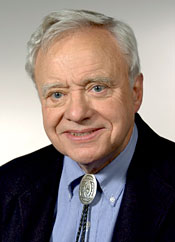Manuel Cardona Castro
DOI: 10.1063/PT.3.2695
Manuel Cardona Castro passed away unexpectedly on 2 July 2014 at the Max Planck Institute for Solid State Research in Stuttgart, Germany, where he had worked since 1971. Cardona’s main interests were in optical spectroscopy and light scattering. Among the methods he employed were modulation spectroscopy, in which he was an early leader, and inelastic light-scattering techniques using both visible lasers and x rays generated by synchrotron radiation.

Manuel Cardona Castro
MAX PLANCK INSTITUTE FOR SOLID STATE RESEARCH/CARMEN-M. MÜLLER

Cardona and his collaborators applied those techniques to study electrons and phonons in bulk semiconductors, semiconductor micro- and nanostructures, tailor-made isotopically pure materials, and high-Tc superconductors in the normal and superconducting states. In addition to his many experimental achievements, Cardona also contributed to theoretical semiconductor physics. He was an innovator in applying the k ∙ p approximation to understand the full-zone band structure of electrons, their effective masses, and g-factors. His other contributions to theory include the computation of the deformation potential mechanism of the electron–phonon interaction and the renormalization of the bandgap of elemental semiconductors, such as diamond, due to electron–phonon interactions.
Cardona was born in Catalonia, Spain, on 7 September 1934. As a young boy he traveled throughout Europe and learned several languages. That knowledge became one of his well-known skills; often he would stop in the middle of a conversation in one language and change to another spoken by a visitor. After obtaining a master’s in physics in 1955 from the University of Barcelona, Cardona joined the University of Madrid as an instructor for electronics. In 1956 he was awarded a graduate fellowship to Harvard University to work under William Paul. He investigated the dielectric properties of semiconductors—in particular, germanium and silicon. With that work as his thesis, he received a PhD in applied physics from Harvard in 1959.
That same year Cardona joined RCA Laboratories in Zürich as a member of the technical staff. There he extended his reflectance work to III–V semiconductors. In 1961 he moved to RCA Labs in Princeton, New Jersey, where he continued to work on the optical properties of semiconductors and started investigating their microwave properties. He introduced a notation to label peaks in the reflectance spectra of semiconductors according to the specific parts of the energy-band structure in momentum space where the peaks originate. That notation also highlights peaks that are related via spin–orbit splitting. His notation has since become the standard method for labeling reflectance spectra of semiconductors.
Between 1964 and 1971, Cardona was a member of the physics faculty of Brown University. He spent the summer of 1965 as a visiting professor at the University of Buenos Aires under the auspices of the Ford Foundation. Between 1969 and 1970, he received a John S. Guggenheim Memorial Scholarship, which allowed him to spend a year at the German Electron Synchrotron in Hamburg, Germany, where he studied the vacuum-UV optical properties of semiconductors. In 1971 he moved to Stuttgart as one of the founding directors of the recently created Max Planck Institute for Solid State Research. His activities there came to have a global impact. Although he retired in 2000, he continued to collaborate daily with numerous scientists throughout Europe, the Americas, and elsewhere until his death.
Cardona authored or coauthored more than 1300 publications in international journals and is one of the eight most cited physicists since 1970. He wrote or edited 10 monographs on solid-state physics and cowrote a textbook on semiconductors. Beginning in 1972 Cardona served on the editorial boards of seven journals, including being the editor-in-chief of Solid State Communications from 1992 to 2004. He received the 1984 Frank Isakson Prize for Optical Effects in Solids and the 1997 John Wheatley Award from the American Physical Society, the 2001 Mott Medal and Prize from the Institute of Physics, the 2004 Blaise Pascal Medal in Physics from the European Academy of Sciences, and numerous other prestigious honors.
In his memory, a special symposium entitled “Electrons, Phonons, and Photons in Semiconductors” was recently held at the Max Planck Institute for Solid State Research. The gathering was attended by more than 100 of his former students, postdoctoral fellows, and collaborators from around the world. The physics community and many others who have known him will miss him immensely and remember him for his encyclopedic knowledge of semiconductors and superconductors, his sense of humor, and most of all, his warm and generous personality.
More about the Authors
Jack Rowe. North Carolina State University, Raleigh.
Dave Aspnes. North Carolina State University, Raleigh.
Aron Pinczuk. Columbia University, New York City.
Peter Y. Yu. University of California, Berkeley.
